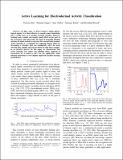| dc.contributor.author | Xia, Victoria F. | |
| dc.contributor.author | Jaques, Natasha Mary | |
| dc.contributor.author | Taylor, Sara Ann | |
| dc.contributor.author | Fedor, Szymon | |
| dc.contributor.author | Picard, Rosalind W. | |
| dc.date.accessioned | 2017-05-26T19:27:35Z | |
| dc.date.available | 2017-05-26T19:27:35Z | |
| dc.date.issued | 2016-02 | |
| dc.date.submitted | 2015-12 | |
| dc.identifier.isbn | 978-1-5090-1350-0 | |
| dc.identifier.uri | http://hdl.handle.net/1721.1/109392 | |
| dc.description.abstract | To filter noise or detect features within physiological signals, it is often effective to encode expert knowledge into a model such as a machine learning classifier. However, training such a model can require much effort on the part of the researcher; this often takes the form of manually labeling portions of signal needed to represent the concept being trained. Active learning is a technique for reducing human effort by developing a classifier that can intelligently select the most relevant data samples and ask for labels for only those samples, in an iterative process. In this paper we demonstrate that active learning can reduce the labeling effort required of researchers by as much as 84% for our application, while offering equivalent or even slightly improved machine learning performance. | en_US |
| dc.description.sponsorship | MIT Media Lab Consortium | en_US |
| dc.description.sponsorship | Robert Wood Johnson Foundation | en_US |
| dc.language.iso | en_US | |
| dc.publisher | Institute of Electrical and Electronics Engineers (IEEE) | en_US |
| dc.relation.isversionof | http://dx.doi.org/10.1109/SPMB.2015.7405467 | en_US |
| dc.rights | Creative Commons Attribution-Noncommercial-Share Alike | en_US |
| dc.rights.uri | http://creativecommons.org/licenses/by-nc-sa/4.0/ | en_US |
| dc.source | MIT web domain | en_US |
| dc.title | Active learning for electrodermal activity classification | en_US |
| dc.type | Article | en_US |
| dc.identifier.citation | Xia, Victoria, Natasha Jaques, Sara Taylor, Szymon Fedor, and Rosalind Picard. “Active Learning for Electrodermal Activity Classification.” 2015 IEEE Signal Processing in Medicine and Biology Symposium (SPMB) (December 2015). | en_US |
| dc.contributor.department | Massachusetts Institute of Technology. Media Laboratory. Affective Computing Group | en_US |
| dc.contributor.department | Massachusetts Institute of Technology. Department of Electrical Engineering and Computer Science | en_US |
| dc.contributor.department | Massachusetts Institute of Technology. Media Laboratory | en_US |
| dc.contributor.department | Program in Media Arts and Sciences (Massachusetts Institute of Technology) | en_US |
| dc.contributor.mitauthor | Xia, Victoria F. | |
| dc.contributor.mitauthor | Jaques, Natasha Mary | |
| dc.contributor.mitauthor | Taylor, Sara Ann | |
| dc.contributor.mitauthor | Fedor, Szymon | |
| dc.contributor.mitauthor | Picard, Rosalind W. | |
| dc.relation.journal | 2015 IEEE Signal Processing in Medicine and Biology Symposium (SPMB) | en_US |
| dc.eprint.version | Author's final manuscript | en_US |
| dc.type.uri | http://purl.org/eprint/type/ConferencePaper | en_US |
| eprint.status | http://purl.org/eprint/status/NonPeerReviewed | en_US |
| dspace.orderedauthors | Xia, Victoria; Jaques, Natasha; Taylor, Sara; Fedor, Szymon; Picard, Rosalind | en_US |
| dspace.embargo.terms | N | en_US |
| dc.identifier.orcid | https://orcid.org/0000-0002-8413-9469 | |
| dc.identifier.orcid | https://orcid.org/0000-0003-4133-9230 | |
| dc.identifier.orcid | https://orcid.org/0000-0002-9857-0188 | |
| dc.identifier.orcid | https://orcid.org/0000-0002-5661-0022 | |
| mit.license | OPEN_ACCESS_POLICY | en_US |
